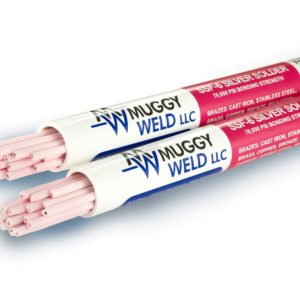How to Repair a Large Aluminum Holes in and A/C line
One question we encounter frequently when demonstrating Super Alloy 5 at professional repair shops is “That product works great for small holes & cracks, but how will it work with larger gaps and holes?”
Aluminum is both lightweight and corrosion resistant, making it an attractive choice for many parts and industries. Unfortunately, many radiator and air conditioning repair shops won’t even attempt to repair damaged aluminum and opt to replace the part at a significantly higher price. Their hesitance often centers around aluminum’s tendency to overheat when using other aluminum welding rods on the market. Aluminum has a melting point of 660°C (1220°F) and does not change color before liquefying, so it’s very important to use a product with a low working temperature to protect the parent metal. Fortunately, Super Alloy 5’s 600°F gives the wiggle room many repair professionals need when attempting aluminum repairs.
Super Alloy 5 differs from other aluminum welding rods on the market for many reasons:
- Low 600°F working temperature
- Works in all positions: overhead, vertical, horizontal
- The unique powder flux transforms from powder to liquid when the parent metal reaches proper working temperature, and pre-cleans the metal to ensure proper bonding
- Works with nearly any torch and can be used as a TIG rod
- Creates 30,000 psi bonds (stronger than the parent metal)
- Can be used to bridge gaps, seal tight-fitting joints, or build up missing sections
- Ideal for cast aluminum applications and aluminum boat repairs
- Perfect color match to aluminum
- Resulting bonds can be drilled, tapped, bent, anodized, machined, plated, or threaded
In this video clip, an air conditioning line with a dime-sized hole is repaired with Super Alloy 5 aluminum rod and flux repair kit.
TIPS:
- Notice the technique: we approach the repair from the side when using oxyacetylene, to avoid overheating and melting thin aluminum. Rather than applying constant heat, the torch is moved away from the parent metal from time to time to allow the metal to cool slightly, solidify, and build upon itself.
- To increase bonding strength, always add flux every time you add rod.
Note: Please observe all AWS Safety & Health Guidelines when using Muggy Weld products.
Check Out These Products
-

Silver Solder Rod: Flux-Coated SSF-6 56% Brazing Rod
$69.00 – $260.00High-Strength, 56% Silver Solder Rod🌡 Melting Temperature 1150 / 621 ⇄︎ Bonding Strength 70000 psi, 482.63 MPa 🔧︎ Sizes Available (in) 1/16 🔧︎ Sizes Available (mm) 1.58 -

Super Alloy 5 Aluminum Welding and Brazing Rod
$69.00 – $109.00600°F aluminum welding, brazing, and soldering rod. Ideal for aluminum boat repair and cast aluminum.🌡 Melting Temperature 600 / 317 ⇄︎ Bonding Strength 30000 psi, 206.84 MPa

